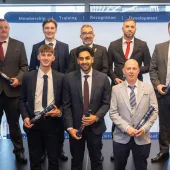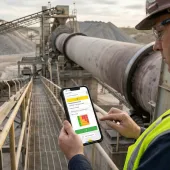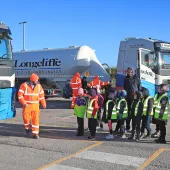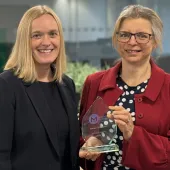Health and Safety Conference 2013
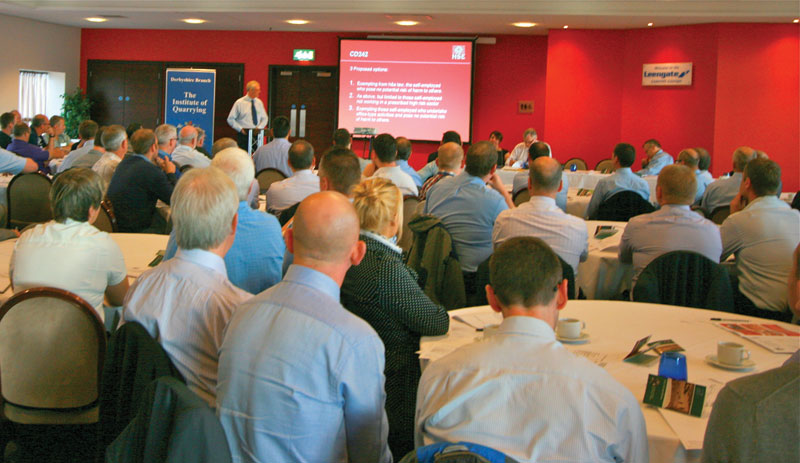
First published in the January 2014 issue of Quarry Management as Health and Safety in Focus
Institute of Quarrying’s Derbyshire branch and the HSE host second annual Safety Conference
On 9 October 2013, the Derbyshire branch held its second annual Safety Conference, in conjunction with the Health and Safety Executive (HSE), at the Proact Stadium in Chesterfield, to deliver a variety of presentations from several specialists within the industry. The day started with an introduction from HSE’s Richard Noble and chair of the Derbyshire branch, Kim Shilcock, who highlighted the success of the conference in terms of interest with the event becoming oversubscribed.
Roy Bush gave the opening presentation with an update on HSE activities, including review status of all 53 ACoPs, likely to be completed by the end of 2014. Mr Bush followed on by publicizing the series of QNJAC seminars taking place throughout the country, highlighting their popularity with 183 attending at Scotch Corner and more than 300 attending the previous two events. Moving on, Mr Bush showed that between 2000 and 2011 annual accident rates had largely plateaued. However, he said there had been an increase in the proportion of major accidents and he challenged the industry to fight this trend.
Next, after an introduction to his company, Huw Richards of Walters Plant Hire gave a view on safety from the perspective of a contractor. He suggested that the key to success is through core values including competent people, training, clear objectives and expectations, management systems, clear lines of communication, visible felt leadership, and partnership in ‘The Walters Way’. Mr Walters demonstrated that a business-support team with access to a database can quickly identify operator competence and training card expiration.
After a short coffee break, Alan Millband, a lawyer with Shakespeares, gave a talk on health and safety law ‘when things go wrong in the extractive industry’. He pointed out that it is often the same things that go wrong, with mismanagement of contractors, waste-of-time audits, taking risks for granted and incompetence being among the reasons for failures. He also showed that the cost of a failure in health and safety is not just composed of the visible cost of enforcement, prosecution and penalties, but is also accompanied by the hidden costs of reputation and commercial harm, as well as the possibility of imprisonment of management staff.
The next speaker, Simon Taylor of Simon Taylor Consulting, gave a director’s perspective on safety and shared his experiences. He highlighted keys to success through competence, managing risks, monitoring and review, and leadership, emphasizing that there are no ‘silver bullets’ and that the safety journey is not a simple one. ‘The Queen must think the world smells of paint’ he joked, suggesting that what is shown is often not real safety. Making reference to Isaac Newton, Mr Taylor suggested that you only get out what you put in, and that listening and asking questions helps with understanding the issues.
John Carlton, a consultant for Cromwell Wood Estates, discussed the Mining Waste Directive and geotechnical matters, focusing on the methods of reducing risk throughout a quarrying operation by engineering risk out of the design of a quarry. ‘How can we achieve an environment where there are no risks? This is a manager’s objective,’ he stated, before discussing a future vision using materials such as imported or mining waste to produce safety structures or aid restoration. This could be helped by removing recovered and inert waste from the Landfill Directive. He concluded that future sites could be restored back to a land use other than agricultural.
After lunch Richard Noble lauded the first anniversary of Fee For Intervention, stating that there had been more than 5,700 invoices in the first six months averaging £464. He suggested that the industry could do more to decrease accidents and incidents, and illustrated a number of failures in health and safety, such as the fly-rock incident at Brayford Quarry in 2011. Mr Noble also made reference to the 66th anniversary of the Aberfan disaster and the more recent Hatfield Colliery tip failure, which left a section of railway destroyed. Reiterating Alan Millband’s presentation, Mr Noble stated that the cost of incidents is the tip of the iceberg.
The final talk was given by Peter Spillard from Spillard Safety Systems, who gave an insight into the safety of large mobile plant. Hundreds of machine visibility studies have been carried out with around 200 blind-spot maps created highlighting the often limited visibility that vehicles have. Mr Spillard summarized the benefits of each system, including the Optronics 360 all-round visibility system, before making a surprising statement that although machines have improved over time, visibility has actually decreased with the introduction of new technology such as engine emission improvements, which increase engine bay sizes. He concluded that everyone needs to understand the importance of visibility and that educating people is key.
The conference finished with questions and answers, and it is thanks to the event organizers, venue staff and the speakers that the day was an overall success which delivered an excellent and diverse insight into health and safety from different viewpoints within the industry.
- Subscribe to Quarry Management, the monthly journal for the mineral products industry, to read articles before they appear on Agg-Net


